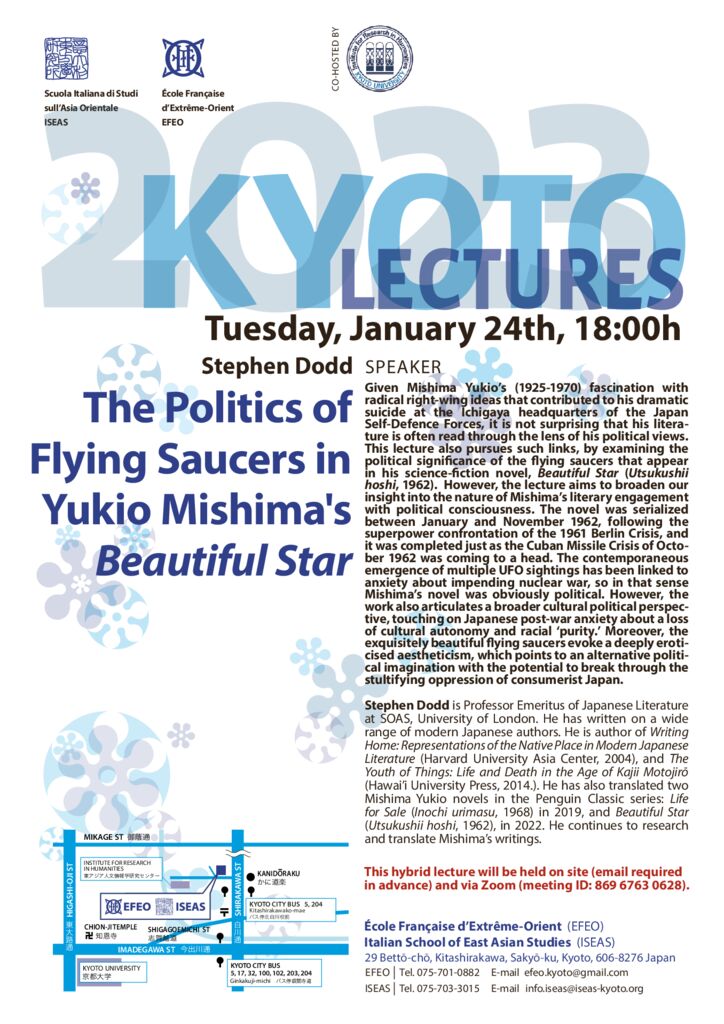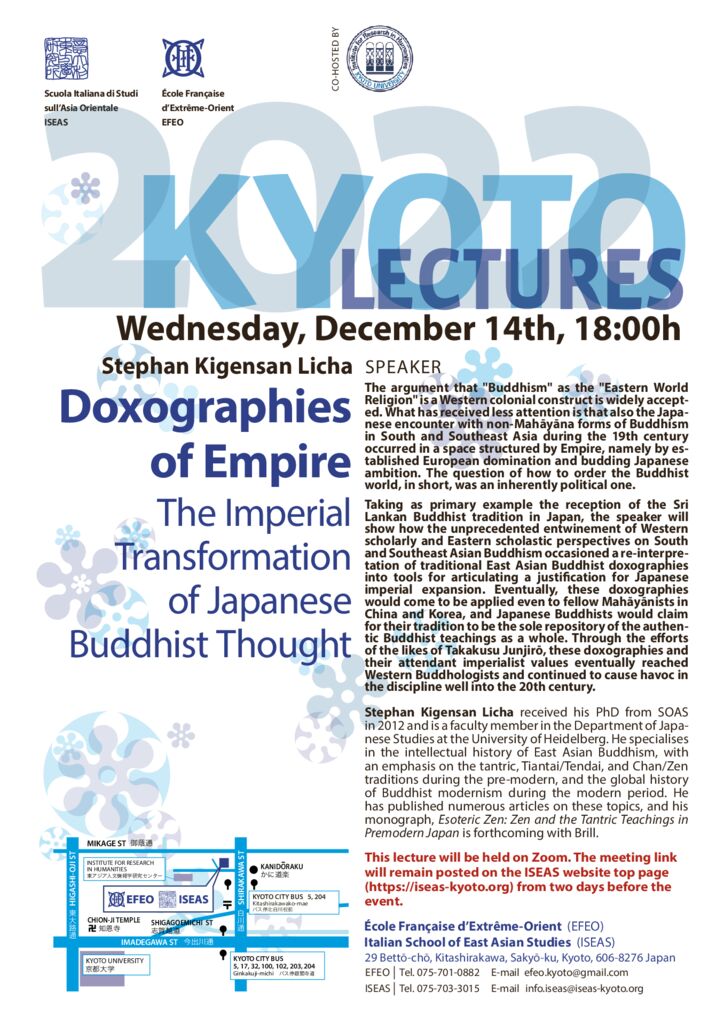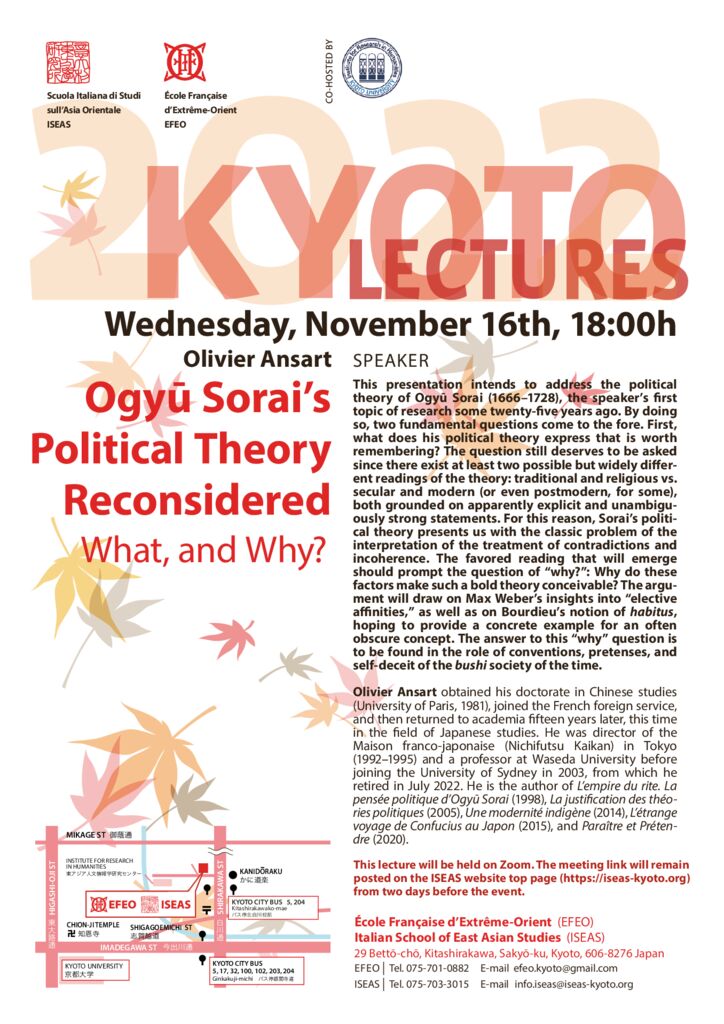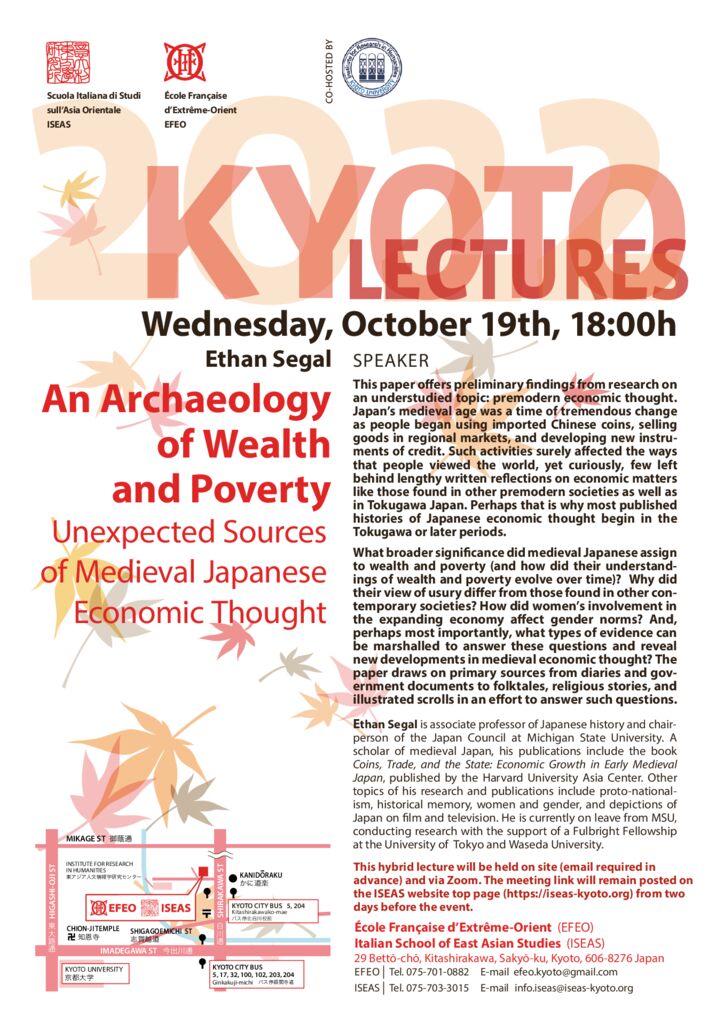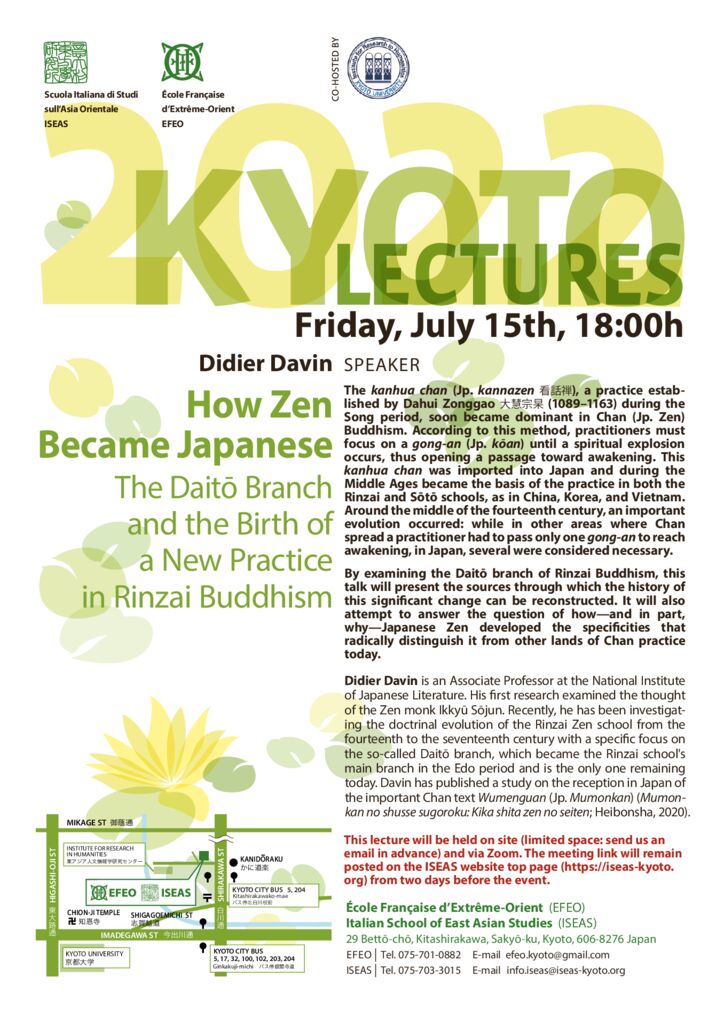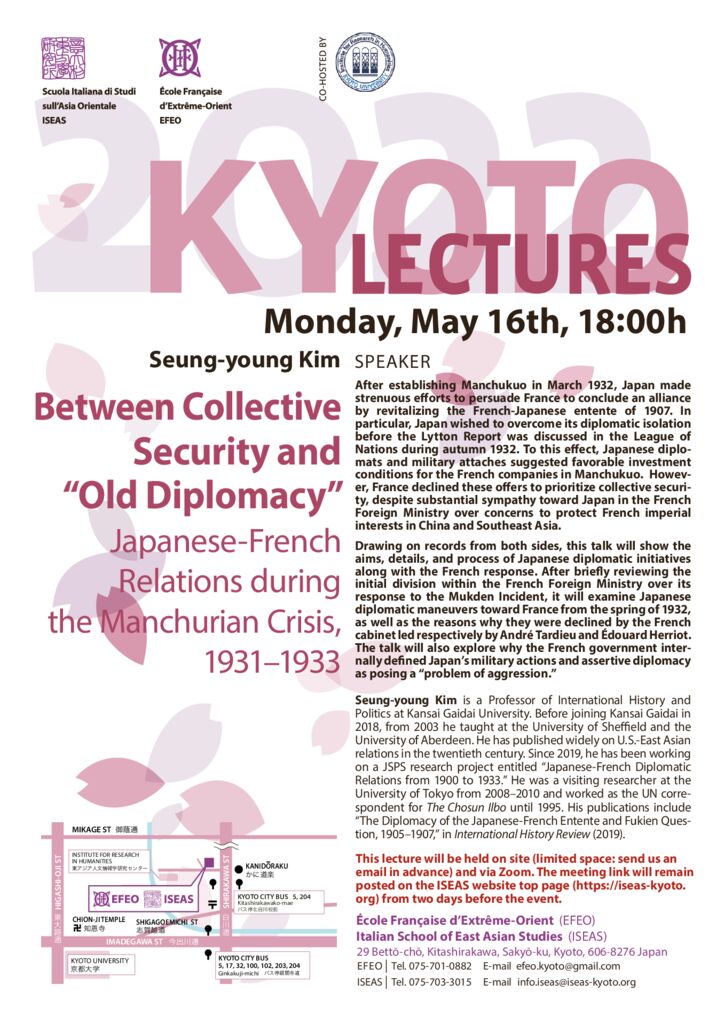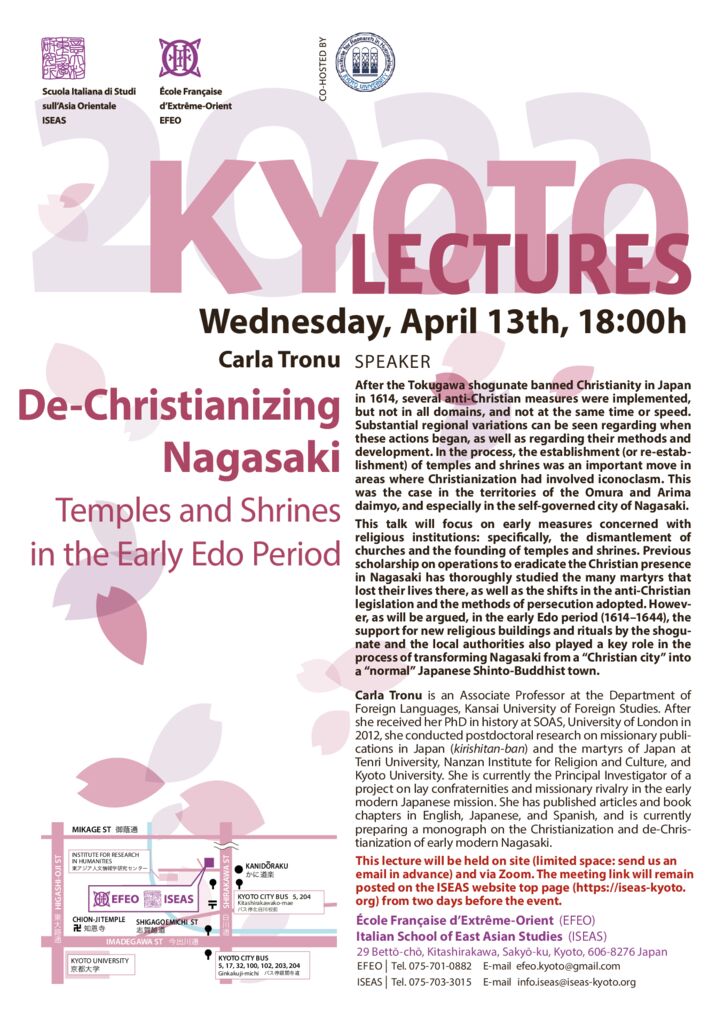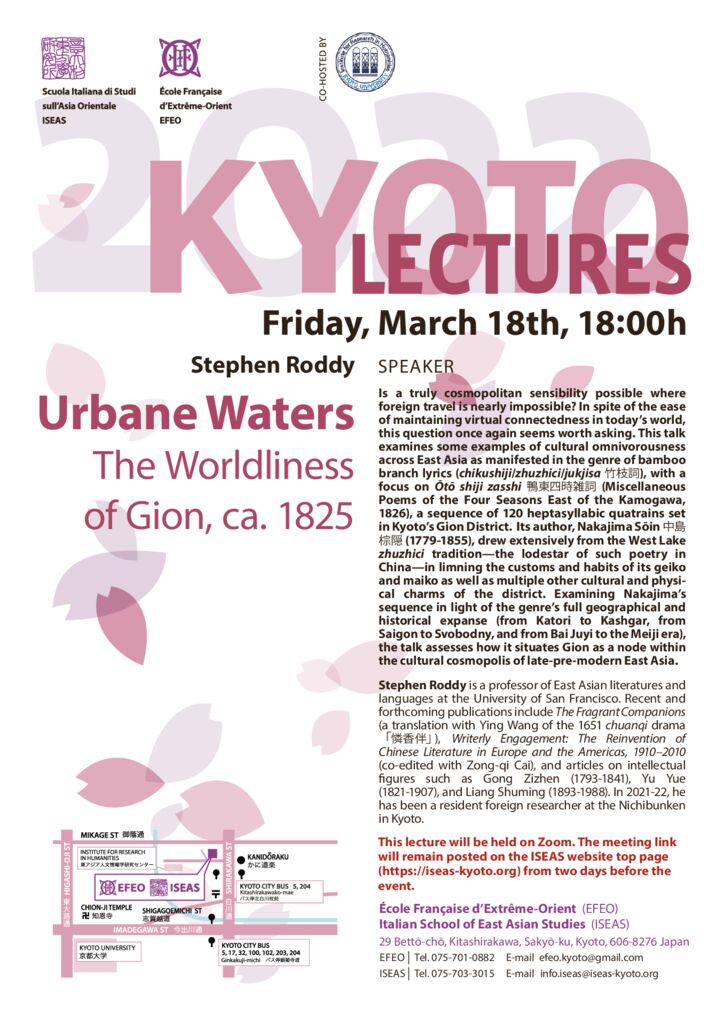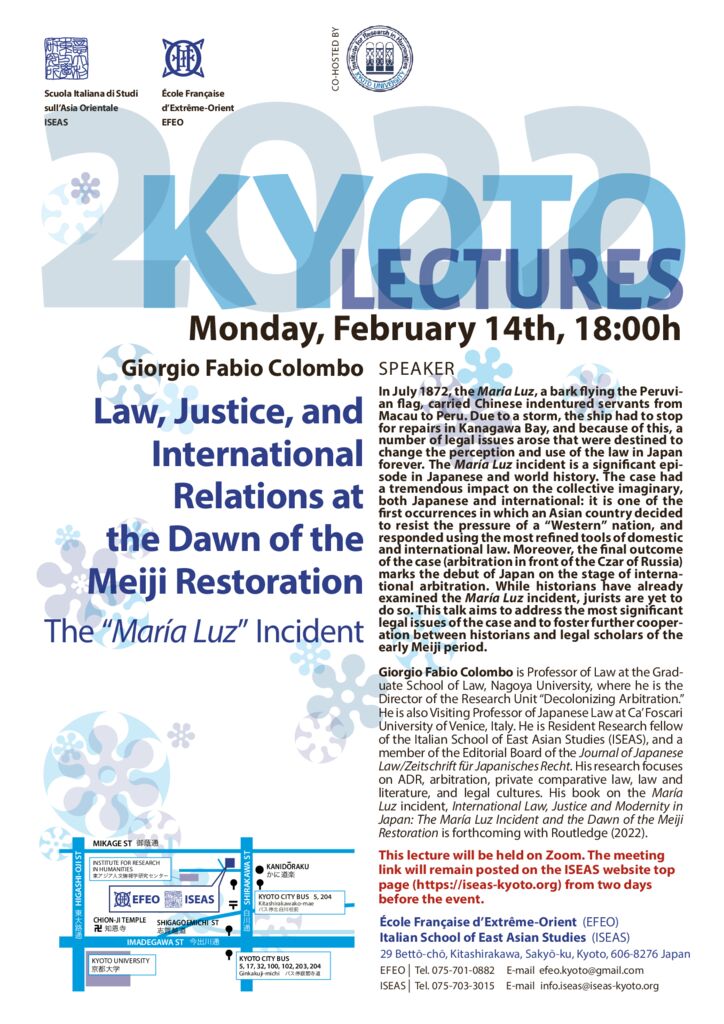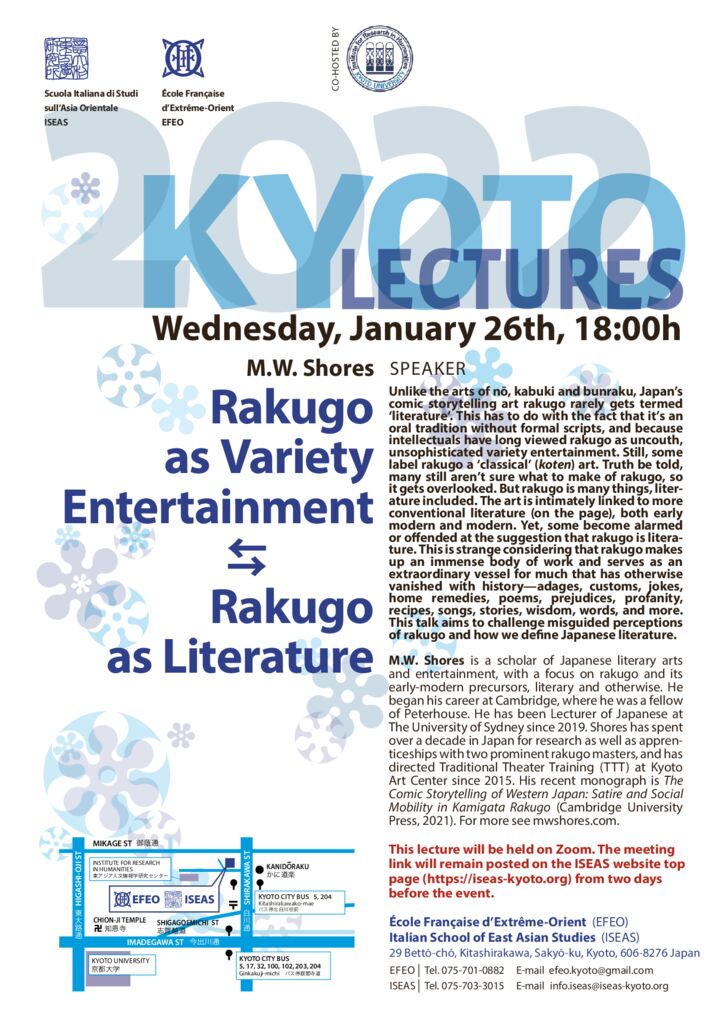Kyoto Lectures
The Politics of Flying Saucers in Yukio Mishima’s Beautiful Star
Stephen Dodd
January 24th, 2023 18:00
This lecture will be held on site and via Zoom
Given Mishima Yukio’s (1925-1970) fascination with radical right-wing ideas that contributed to his dramatic suicide at the Ichigaya headquarters of the Japan Self-Defence Forces, it is not surprising that his literature is often read through the lens of his political views. This lecture also pursues such links, by examining the political significance of the flying saucers that appear in his science-fiction novel, Beautiful Star (Utsukushii hoshi, 1962). However, the lecture aims to broaden our insight into the nature of Mishima’s literary engagement with political consciousness. The novel was serialized between January and November 1962, following the superpower confrontation of the 1961 Berlin Crisis, and it was completed just as the Cuban Missile Crisis of October 1962 was coming to a head. The contemporaneous emergence of multiple UFO sightings has been linked to anxiety about impending nuclear war, so in that sense Mishima’s novel was obviously political. However, the work also articulates a broader cultural political perspective, touching on Japanese post-war anxiety about a loss of cultural autonomy and racial ‘purity.’ Moreover, the exquisitely beautiful flying saucers evoke a deeply eroticised aestheticism, which points to an alternative political imagination with the potential to break through the stultifying oppression of consumerist Japan.
Stephen Dodd is Professor Emeritus of Japanese Literature at SOAS, University of London. He has written on a wide range of modern Japanese authors. He is author of Writing Home: Representations of the Native Place in Modern Japanese Literature (Harvard University Asia Center, 2004), and The Youth of Things: Life and Death in the Age of Kajii Motojirō (Hawai’i University Press, 2014.). He has also translated two Mishima Yukio novels in the Penguin Classic series: Life for Sale (Inochi urimasu, 1968) in 2019, and Beautiful Star (Utsukushii hoshi, 1962), in 2022. He continues to research and translate Mishima’s writings.
This hybrid lecture will be held on site (email required in advance) and via Zoom (meeting ID: 869 6763 0628).
Kyoto Lectures
Doxographies of Empire
The Imperial Transformation of Japanese Buddhist Thought
Stephan Kigensan Licha
December 14th, 2022 18:00
This lecture will be available only on Zoom
The argument that “Buddhism” as the “Eastern World Religion” is a Western colonial construct is widely accepted. What has received less attention is that also the Japanese encounter with non-Mahāyāna forms of Buddhism in South and Southeast Asia during the 19th century occurred in a space structured by Empire, namely by established European domination and budding Japanese ambition. The question of how to order the Buddhist world, in short, was an inherently political one.
Taking as primary example the reception of the Sri Lankan Buddhist tradition in Japan, the speaker will show how the unprecedented entwinement of Western scholarly and Eastern scholastic perspectives on South and Southeast Asian Buddhism occasioned a re-interpretation of traditional East Asian Buddhist doxographies into tools for articulating a justification for Japanese imperial expansion. Eventually, these doxographies would come to be applied even to fellow Mahāyānists in China and Korea, and Japanese Buddhists would claim for their tradition to be the sole repository of the authentic Buddhist teachings as a whole. Through the efforts of the likes of Takakusu Junjirō, these doxographies and their attendant imperialist values eventually reached Western Buddhologists and continued to cause havoc in the discipline well into the 20th century.
Stephan Kigensan Licha received his PhD from SOAS in 2012 and is a faculty member in the Department of Japanese Studies at the University of Heidelberg. He specialises in the intellectual history of East Asian Buddhism, with an emphasis on the tantric, Tiantai/Tendai, and Chan/Zen traditions during the pre-modern, and the global history of Buddhist modernism during the modern period. He has published numerous articles on these topics, and his monograph, Esoteric Zen: Zen and the Tantric Teachings in Premodern Japan is forthcoming with Brill.
The meeting link will remain posted on the ISEAS website top page from december 12.
Kyoto Lectures
Ogyū Sorai’s Political Theory Reconsidered
What, and Why?
Olivier Ansart
November 16th, 2022 18:00
This lecture will be available only on Zoom
This presentation intends to address the political theory of Ogyū Sorai (1666–1728), the speaker’s first topic of research some twenty-five years ago. By doing so, two fundamental questions come to the fore. First, what does his political theory express that is worth remembering? The question still deserves to be asked since there exist at least two possible but widely different readings of the theory: traditional and religious vs. secular and modern (or even postmodern, for some), both grounded on apparently explicit and unambiguously strong statements. For this reason, Sorai’s political theory presents us with the classic problem of the interpretation of the treatment of contradictions and incoherence. The favored reading that will emerge should prompt the question of “why?”: Why do these factors make such a bold theory conceivable? The argument will draw on Max Weber’s insights into “elective affinities,” as well as on Bourdieu’s notion of habitus, hoping to provide a concrete example for an often obscure concept. The answer to this “why” question is to be found in the role of conventions, pretenses, and self-deceit of the bushi society of the time.
Olivier Ansart obtained his doctorate in Chinese studies (University of Paris, 1981), joined the French foreign service, and then returned to academia fifteen years later, this time in the field of Japanese studies. He was director of the Maison franco-japonaise (Nichifutsu Kaikan) in Tokyo (1992–1995) and a professor at Waseda University before joining the University of Sydney in 2003, from which he retired in July 2022. He is the author of L’empire du rite. La pensée politique d’Ogyū Sorai (1998), La justification des théories politiques (2005), Une modernité indigène (2014), L’étrange voyage de Confucius au Japon (2015), and Paraître et Prétendre (2020).
The meeting link will remain posted on the ISEAS website top page from november 14.
Kyoto Lectures
An Archaeology of Wealth and Poverty
Unexpected Sources of Medieval Japanese Economic Thought
Ethan Segal
October 19th, 2022 18:00
This lecture will be held on site and via Zoom
This paper offers preliminary findings from research on an understudied topic: premodern economic thought. Japan’s medieval age was a time of tremendous change as people began using imported Chinese coins, selling goods in regional markets, and developing new instruments of credit. Such activities surely affected the ways that people viewed the world, yet curiously, few left behind lengthy written reflections on economic matters like those found in other premodern societies as well as in Tokugawa Japan. Perhaps that is why most published histories of Japanese economic thought begin in the Tokugawa or later periods.
What broader significance did medieval Japanese assign to wealth and poverty (and how did their understandings of wealth and poverty evolve over time)? Why did their view of usury differ from those found in other contemporary societies? How did women’s involvement in the expanding economy affect gender norms? And, perhaps most importantly, what types of evidence can be marshalled to answer these questions and reveal new developments in medieval economic thought? The paper draws on primary sources from diaries and government documents to folktales, religious stories, and illustrated scrolls in an effort to answer such questions.
Ethan Segal is associate professor of Japanese history and chairperson of the Japan Council at Michigan State University. A scholar of medieval Japan, his publications include the book Coins, Trade, and the State: Economic Growth in Early Medieval Japan, published by the Harvard University Asia Center. Other topics of his research and publications include proto-nationalism, historical memory, women and gender, and depictions of Japan on film and television. He is currently on leave from MSU, conducting research with the support of a Fulbright Fellowship at the University of Tokyo and Waseda University.
This hybrid lecture will be held on site (email required in advance) and via Zoom. The meeting link will remain posted on the ISEAS website top page from two days before the event.
Kyoto Lectures
How Zen Became Japanese
The Daitō Branch and the Birth of a New Practice in Rinzai Buddhism
Didier Davin
July 15th, 2022 18:00
This lecture will be held on site and via Zoom
The kanhua chan (Jp. kannazen 看話禅), a practice established by Dahui Zonggao 大慧宗杲 (1089–1163) during the Song period, soon became dominant in Chan (Jp. Zen) Buddhism. According to this method, practitioners must focus on a gong-an (Jp. kōan) until a spiritual explosion occurs, thus opening a passage toward awakening. This kanhua chan was imported into Japan and during the Middle Ages became the basis of the practice in both the Rinzai and Sōtō schools, as in China, Korea, and Vietnam. Around the middle of the fourteenth century, an important evolution occurred: while in other areas where Chan spread a practitioner had to pass only one gong-an to reach awakening, in Japan, several were considered necessary.
By examining the Daitō branch of Rinzai Buddhism, this talk will present the sources through which the history of this significant change can be reconstructed. It will also attempt to answer the question of how—and in part, why—Japanese Zen developed the specificities that radically distinguish it from other lands of Chan practice today.
Didier Davin is an Associate Professor at the National Institute of Japanese Literature. His first research examined the thought of the Zen monk Ikkyū Sōjun. Recently, he has been investigating the doctrinal evolution of the Rinzai Zen school from the fourteenth to the seventeenth century with a specific focus on the so-called Daitō branch, which became the Rinzai school’s main branch in the Edo period and is the only one remaining today. Davin has published a study on the reception in Japan of the important Chan text Wumenguan (Jp. Mumonkan) (Mumonkan no shusse sugoroku: Kika shita zen no seiten; Heibonsha, 2020).
This lecture will be held on site (limited space: send us an email in advance) and via Zoom. The meeting link will remain posted on the ISEAS website top page from two days before the event.
Kyoto Lectures
Between Collective Security and “Old Diplomacy”
Japanese-French Relations during the Manchurian Crisis, 1931–1933
Seung-young Kim
May 16th, 2022 18:00
This lecture will be held on site and via Zoom
After establishing Manchukuo in March 1932, Japan made strenuous efforts to persuade France to conclude an alliance by revitalizing the French-Japanese entente of 1907. In particular, Japan wished to overcome its diplomatic isolation before the Lytton Report was discussed in the League of Nations during autumn 1932. To this effect, Japanese diplomats and military attaches suggested favorable investment conditions for the French companies in Manchukuo. However, France declined these offers to prioritize collective security, despite substantial sympathy toward Japan in the French Foreign Ministry over concerns to protect French imperial interests in China and Southeast Asia.
Drawing on records from both sides, this talk will show the aims, details, and process of Japanese diplomatic initiatives along with the French response. After briefly reviewing the initial division within the French Foreign Ministry over its response to the Mukden Incident, it will examine Japanese diplomatic maneuvers toward France from the spring of 1932, as well as the reasons why they were declined by the French cabinet led respectively by André Tardieu and Édouard Herriot. The talk will also explore why the French government internally defined Japan’s military actions and assertive diplomacy as posing a “problem of aggression.”
Seung-young Kim is a Professor of International History and Politics at Kansai Gaidai University. Before joining Kansai Gaidai in 2018, from 2003 he taught at the University of Sheffield and the University of Aberdeen. He has published widely on U.S.-East Asian relations in the twentieth century. Since 2019, he has been working on a JSPS research project entitled “Japanese-French Diplomatic Relations from 1900 to 1933.” He was a visiting researcher at the University of Tokyo from 2008–2010 and worked as the UN correspondent for The Chosun Ilbo until 1995. His publications include “The Diplomacy of the Japanese-French Entente and Fukien Question, 1905–1907,” in International History Review (2019).
This lecture will be held on site (limited space: send us an email in advance) and via Zoom. The meeting link will remain posted on the ISEAS website top page from two days before the event.
Kyoto Lectures
De-Christianizing Nagasaki
Temples and Shrines in the Early Edo period
Carla Tronu
April 13th, 2022 18:00
This lecture will be held on site and via Zoom
After the Tokugawa shogunate banned Christianity in Japan in 1614, several anti-Christian measures were implemented, but not in all domains, and not at the same time or speed. Substantial regional variations can be seen regarding when these actions began, as well as regarding their methods and development. In the process, the establishment (or re-establishment) of temples and shrines was an important move in areas where Christianization had involved iconoclasm. This was the case in the territories of the Omura and Arima daimyo, and especially in the self-governed city of Nagasaki.
This talk will focus on early measures concerned with religious institutions: specifically, the dismantlement of churches and the founding of temples and shrines. Previous scholarship on operations to eradicate the Christian presence in Nagasaki has thoroughly studied the many martyrs that lost their lives there, as well as the shifts in the anti-Christian legislation and the methods of persecution adopted. However, as will be argued, in the early Edo period (1614–1644), the support for new religious buildings and rituals by the shogunate and the local authorities also played a key role in the process of transforming Nagasaki from a “Christian city” into a “normal” Japanese Shinto-Buddhist town.
Carla Tronu is an Associate Professor at the Department of Foreign Languages, Kansai University of Foreign Studies. After she received her PhD in history at SOAS, University of London in 2012, she conducted postdoctoral research on missionary publications in Japan (kirishitan-ban) and the martyrs of Japan at Tenri University, Nanzan Institute for Religion and Culture, and Kyoto University. She is currently the Principal Investigator of a project on lay confraternities and missionary rivalry in the early modern Japanese mission. She has published articles and book chapters in English, Japanese, and Spanish, and is currently preparing a monograph on the Christianization and de-Christianization of early modern Nagasaki.
This lecture will be held on site (limited space: send us an email in advance) and via Zoom. The meeting link will remain posted on the ISEAS website top page from two days before the event.
Kyoto Lectures
Urbane Waters
The Worldliness of Gion, ca. 1825
Stephen Roddy
March 18th, 2022 18:00
This lecture will be available only on Zoom
Is a truly cosmopolitan sensibility possible where foreign travel is nearly impossible? In spite of the ease of maintaining virtual connectedness in today’s world, this question once again seems worth asking. This talk examines some examples of cultural omnivorousness across East Asia as manifested in the genre of bamboo branch lyrics (chikushiji/zhuzhici/jukjisa 竹枝詞), with a focus on Ōtō shiji zasshi 鴨東四時雑詞 (Miscellaneous Poems of the Four Seasons East of the Kamogawa, 1826), a sequence of 120 heptasyllabic quatrains set in Kyoto’s Gion District. Its author, Nakajima Sōin 中島棕隠 (1779-1855), drew extensively from the West Lake zhuzhici tradition—the lodestar of such poetry in China—in limning the customs and habits of its geiko and maiko as well as multiple other cultural and physical charms of the district. Examining Nakajima’s sequence in light of the genre’s full geographical and historical expanse (from Katori to Kashgar, from Saigon to Svobodny, and from Bai Juyi to the Meiji era), the talk assesses how it situates Gion as a node within the cultural cosmopolis of late-pre-modern East Asia.
Stephen Roddy is a professor of East Asian literatures and languages at the University of San Francisco. Recent and forthcoming publications include The Fragrant Companions (a translation with Ying Wang of the 1651 chuanqi drama 「憐香伴」), Writerly Engagement: The Reinvention of Chinese Literature in Europe and the Americas, 1910–2010 (co-edited with Zong-qi Cai), and articles on intellectual figures such as Gong Zizhen (1793-1841), Yu Yue (1821-1907), and Liang Shuming (1893-1988). In 2021-22, he has been a resident foreign researcher at the Nichibunken in Kyoto.
The meeting link will remain posted on the ISEAS website top page from march 16.
Kyoto Lectures
Law, Justice, and International Relations at the Dawn of the Meiji Restoration
The “María Luz” Incident
Giorgio Fabio Colombo
February 14th, 2022 18:00
This lecture will be available only on Zoom
In July 1872, the María Luz, a bark flying the Peruvian flag, carried Chinese indentured servants from Macau to Peru. Due to a storm, the ship had to stop for repairs in Kanagawa Bay, and because of this, a number of legal issues arose that were destined to change the perception and use of the law in Japan forever. The María Luz incident is a significant episode in Japanese and world history. The case had a tremendous impact on the collective imaginary, both Japanese and international: it is one of the first occurrences in which an Asian country decided to resist the pressure of a “Western” nation, and responded using the most refined tools of domestic and international law. Moreover, the final outcome of the case (arbitration in front of the Czar of Russia) marks the debut of Japan on the stage of international arbitration. While historians have already examined the María Luz incident, jurists are yet to do so. This talk aims to address the most significant legal issues of the case and to foster further cooperation between historians and legal scholars of the early Meiji period.
Giorgio Fabio COLOMBO is Professor of Law at the Graduate School of Law, Nagoya University, where he is the Director of the Research Unit “Decolonizing Arbitration.” He is also Visiting Professor of Japanese Law at Ca’ Foscari University of Venice, Italy. He is Resident Research fellow of the Italian School of East Asian Studies (ISEAS), and a member of the Editorial Board of the Journal of Japanese Law/Zeitschrift für Japanisches Recht. His research focuses on ADR, arbitration, private comparative law, law and literature, and legal cultures. His book on the María Luz incident, International Law, Justice and Modernity in Japan: The María Luz Incident and the Dawn of the Meiji Restoration is forthcoming with Routledge (2022).
The meeting link will remain posted on the ISEAS website top page from february 12.
Kyoto Lectures
Rakugo as Variety Entertainment ⇆ Rakugo as Literature
M.W. Shores
January 26th, 2022 18:00
This lecture will be available only on Zoom
Unlike the arts of nō, kabuki and bunraku, Japan’s comic storytelling art rakugo rarely gets termed ‘literature’. This has to do with the fact that it’s an oral tradition without formal scripts, and because intellectuals have long viewed rakugo as uncouth, unsophisticated variety entertainment. Still, some label rakugo a ‘classical’ (koten) art. Truth be told, many still aren’t sure what to make of rakugo, so it gets overlooked. But rakugo is many things, literature included. The art is intimately linked to more conventional literature (on the page), both early modern and modern. Yet, some become alarmed or offended at the suggestion that rakugo is literature. This is strange considering that rakugo makes up an immense body of work and serves as an extraordinary vessel for much that has otherwise vanished with history—adages, customs, jokes, home remedies, poems, prejudices, profanity, recipes, songs, stories, wisdom, words, and more. This talk aims to challenge misguided perceptions of rakugo and how we define Japanese literature.
M.W. Shores is a scholar of Japanese literary arts and entertainment, with a focus on rakugo and its early-modern precursors, literary and otherwise. He began his career at Cambridge, where he was a fellow of Peterhouse. He has been Lecturer of Japanese at The University of Sydney since 2019. Shores has spent over a decade in Japan for research as well as apprenticeships with two prominent rakugo masters, and has directed Traditional Theater Training (TTT) at Kyoto Art Center since 2015. His recent monograph is The Comic Storytelling of Western Japan: Satire and Social Mobility in Kamigata Rakugo (Cambridge University Press, 2021). For more see mwshores.com.
The meeting link will remain posted on the ISEAS website top page from january 24.
